20/03/2021 - 29/05/2021
Joachim Koester
The Invisible Index
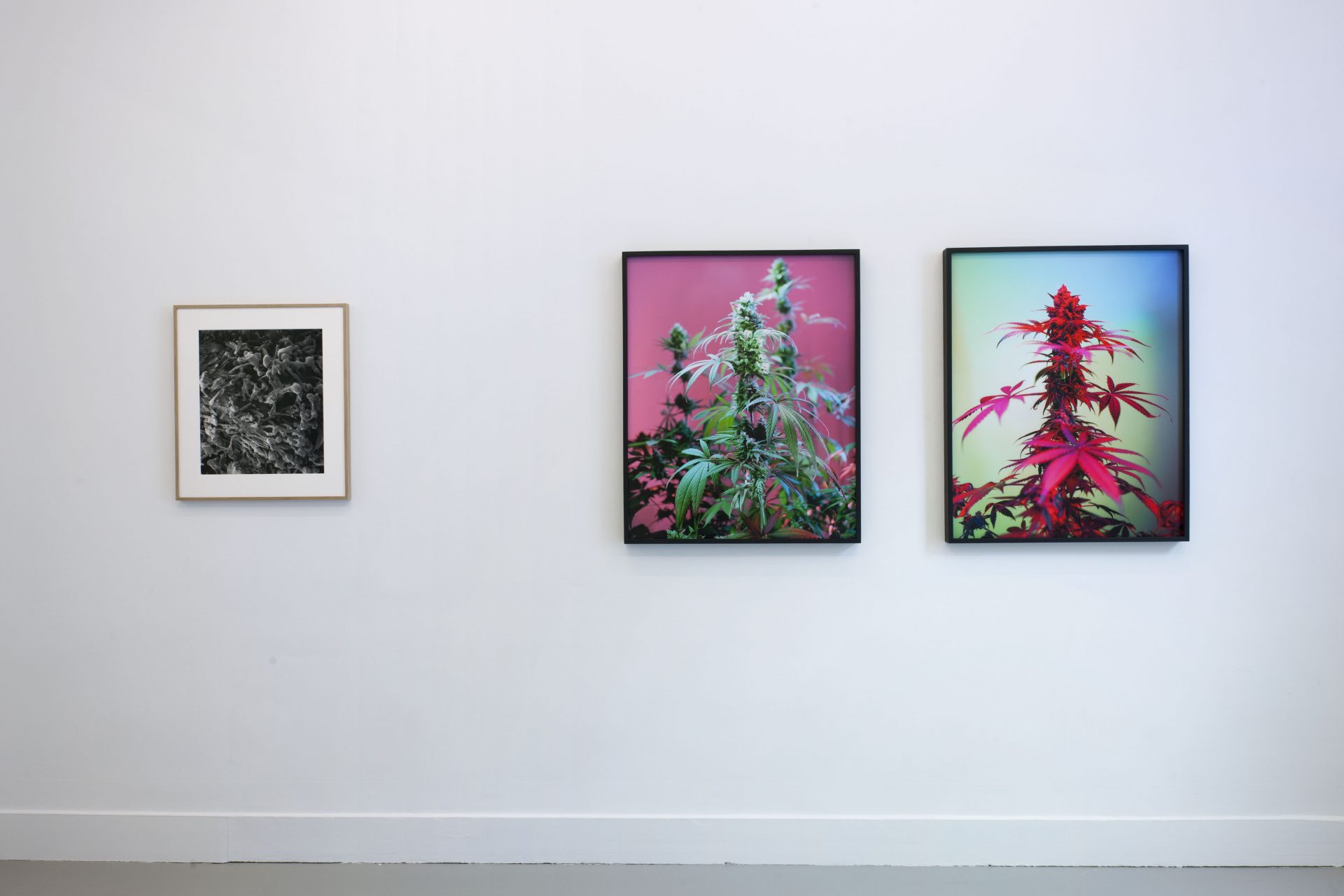
The invisible index, installation view at Jan Mot, 2021 (from left to right: Joachim Koester, Cannabis SEM #4, 2019, silver gelatin print, framed, 56 x 62 cm; Joachim Koester, Cannabis #2, 2019, archival pigment print, framed, 92 x 74 cm; Joachim Koester, Cannabis #4, 2019, archival pigment print, framed, 92 x 74 cm)
Intoxication and Phantom Bodies
an interview between Lars Bang Larsen and Joachim Koester
Lars Bang Larsen: I would like to ask you about "the invisible index of things" - a felicitous phrase of yours that stands as a sort of search term in your research. If the occult is that which per definition is hidden, your "invisible index" can literally be connected to your recurring focus on occult practices and their cultural histories. But this index of the unseen also suggests an inherent tension in relation to the way that history becomes image. After Benjamin, historical memory is understood as the recognition of an image, and so the question is how "the invisible index of things" relates to his idea that "history decays into images," as he put it. How does the invisible index become image, and what happens to it when it is imaged?
Joachim Koester: Last fall I scanned a minuscule amount of cocaine in an SEM microscope. What appeared on the screen was a strange weightless subterranean world, a psychogeography with distinct visual features. I think of these images as sort of concentrate or condensation of the politics and neurological effects of cocaine. Benjamin writes about image worlds so subtle that they appear only in waking dreams. After they are uncovered, they can be interpreted through visual similarities or associations. I think this is what happens to the invisible index after it becomes image; what was hiding, in dreams, or sometimes in plain sight, or in the case of cocaine, right under our noses, can be utilized as part of an ongoing process to create insights into the politics of contemporary life.
LBL: Cocaine! This raises the questions of what kind of image can hold the invisible index. Am I right that the road you take to create such image worlds works by way of teasing out contradictions and tensions? Meaning, the motif or object of your camera is often characterized by being Other: it is something ecstatic, illegitimate, or nonhuman - to put it plainly, things or phenomena that conventionally are represented with visual drama and lots of colors. But counterintuitively, the your camera attitude tends to be dry, objectivizing, on-the-tip-of-your-fork-like. With this dialectic or tension you create something like documents of excess and liminal phenomena, or even a collision between reason and unreason.
JK: The images do not depict the excess of bliss; rather, it is the excess associated with the tunnels of Mordor or free market economy. When coca leaves are turned into cocaine in jungle laboratories, the extraction process involves adding gasoline and cement. After this, the weight of the cocaine is increased at each station of the distribution chain by mixing the powder with cheaper ingredients like Novocain, to create a feeling of numbness in the gums or nose, or levamisole, which seems to have an effect on the nervous system, or even sugar, just because it's white and powdery. It was street cocaine that I scanned, and the compound created some really weird reflections. First, I thought it had to do with the SEM microscope, but it is indeed something in the powder itself that shines. Also, in order to make the SEM scanner work, the cocaine had to be covered in a layer of gold. I didn't know anything about the process beforehand, and I thought it was quite a coincidence that gold had to be added to the mix. The tiny heap of material becomes an alchemical blend of forces, and inside it hides economy that cocaine sustains today. But back to your question - the seemingly sobering way that I sometimes deal with extraordinary or excessive subject matter. I guess one way to answer this is that I'm often more focused on how ideas, histories, and qualities compress as physical material than in unfolding the subject matter through identification.
LBL: Your sobering approach to excess echoes Benjamin again. In his 1929 essay on Surrealism he warned against mysticism and admonished that "any serious exploration of occult, surrealistic, phantasmagoric gifts and phenomena presupposes a dialectical intertwinement." As you engage with these phenomena, their essentialisms and metaphysical claims must be methodically doubted, in other words. Your series of coke microscopies is your most recent work, but what you say about it seems to relate to your 2007 film Tarantism, too, in which dancers let it all hang out in a silent and improvised rave that references the medieval "dancing cure" for the poisonous bite of the wolf spider. This is also a portrayal of intoxication. But I should add that it is quite inviting, though - it may be depicted quite dryly, but it makes you want to dance the tarantella.
JK: Yes, what is depicted is a much more positive form of intoxication. The shaking, hurling, and vibrating bodies of Taratism can be interpreted as the first step of a transformation; a signal from phantom bodies, lost memories and new identities trying to wriggle their way out.
LBL: Does this also apply to the praying mantises in your photographs? Are they phantom bodies, too, indexes of emerging corporealities?
JK: Yes, I think so. There is a Chinese Kung Fu style based on the movements of the praying mantis. Some qualities of the insect were adapted to the style in a quite literal way, like the movements of the insect's front legs when it catches prey or defends itself, but the mantis was also seen as a vehicle for developing supernatural powers - to become telepathic, incredibly fast, weightless, invisible. The names of the different mantises that I photographed also speak to the mysterious and transformative side of its appearance. One is called a Ghost Mantis, another a Devil's Flower Mantis, one a Violin Mantis, and one a Schizocephala Bicornis. They look a bit like little spirits, or aliens, space creatures with unknown powers.

The invisible index, installation view at Jan Mot, 2021 (from left to right: Joachim Koester, Coca Bush Botanical Garden, 2020, inkjet print, framed, 107 x 93 cm; Joachim Koester, Cocaine #3, 2019, silver gelatin print, framed, 56 x 62 cm; Joachim Koester, Cocaine #5, 2019, silver gelatin print, framed, 56 x 62 cm)
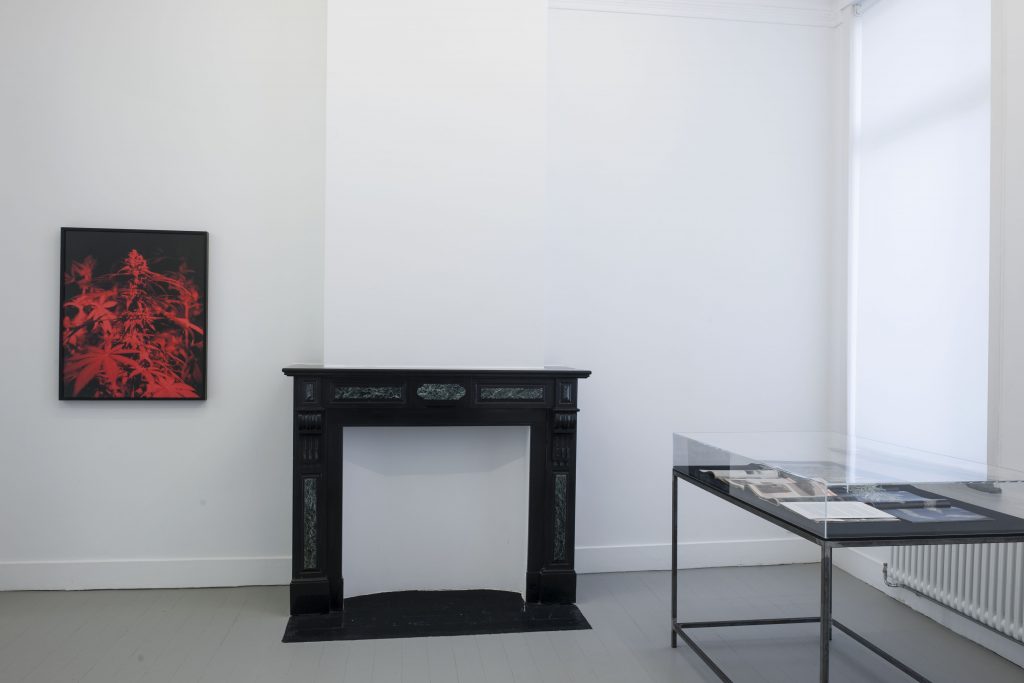
The invisible index, installation view at Jan Mot, 2021 (from left to right: Joachim Koester, Cannabis #3, 2019, archival pigment print, framed, 92 x 74,5 cm; vitrine with magazine copies The High Times and text From the Secret Garden of Sleep that can be found below)
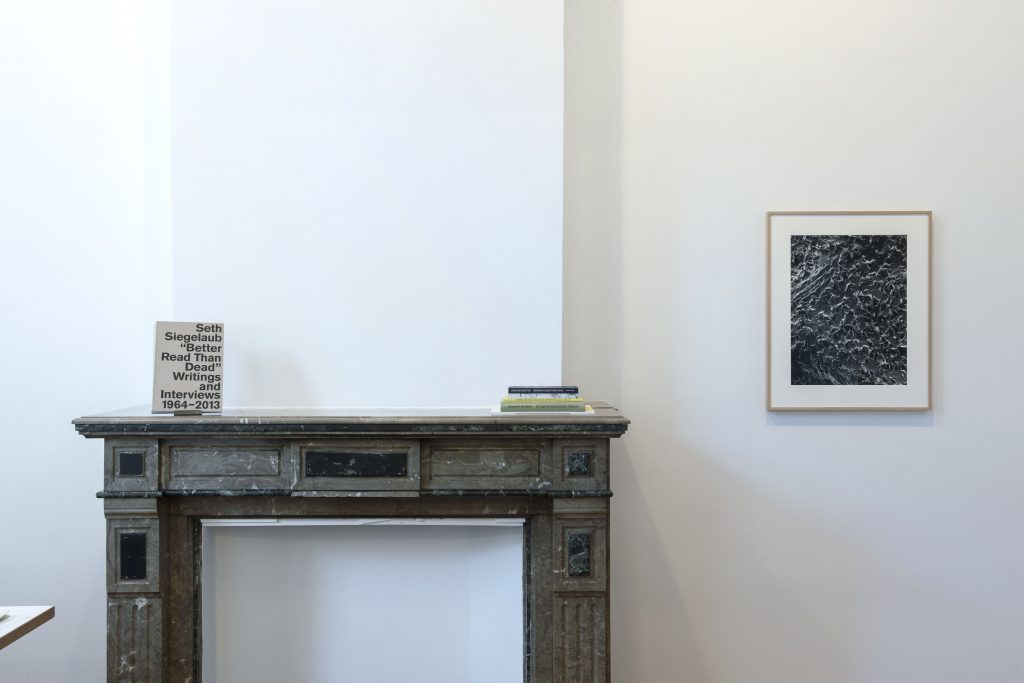
The invisible index, installation view at Jan Mot, 2021 (Joachim Koester, SEM Coca Leaf #1, 2020, silver gelatin print, framed, 66 x 54,5 cm)
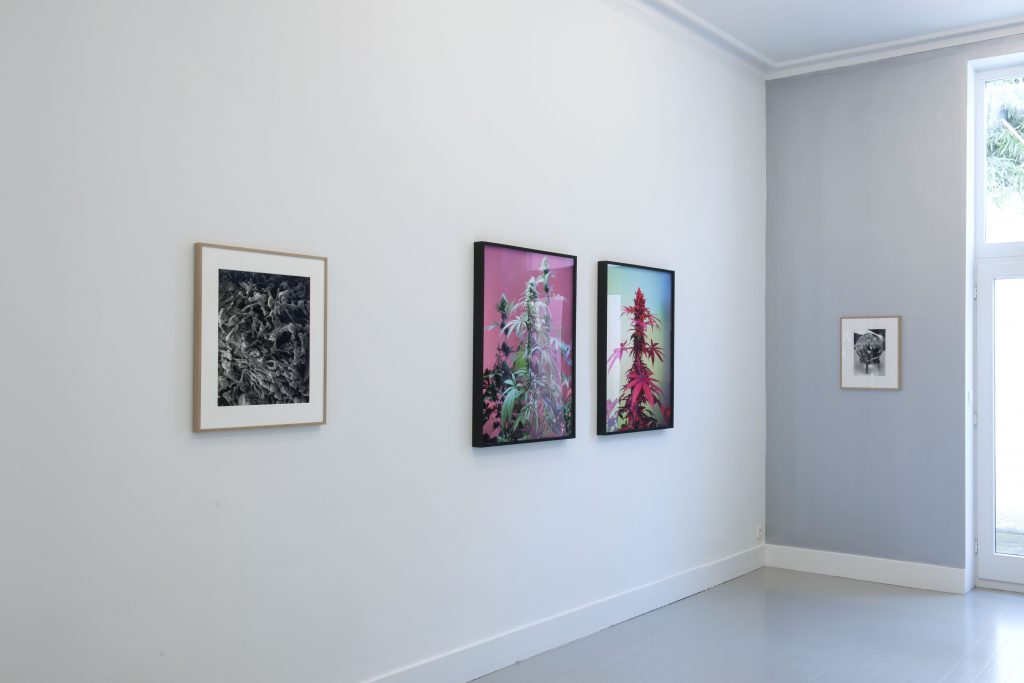
The invisible index, installation view at Jan Mot, 2021 (from left to right: Joachim Koester, Cannabis SEM #4, 2019, silver gelatin print, framed, 56 x 62 cm; Joachim Koester, Cannabis #2, 2019, archival pigment print, framed, 92 x 74 cm; Joachim Koester, Cannabis #4, 2019, archival pigment print, framed, 92 x 74,5 cm; Joachim Koester, Crystal Ball, 2011, silver gelatin print, framed, 57,5 x 46,5 cm)
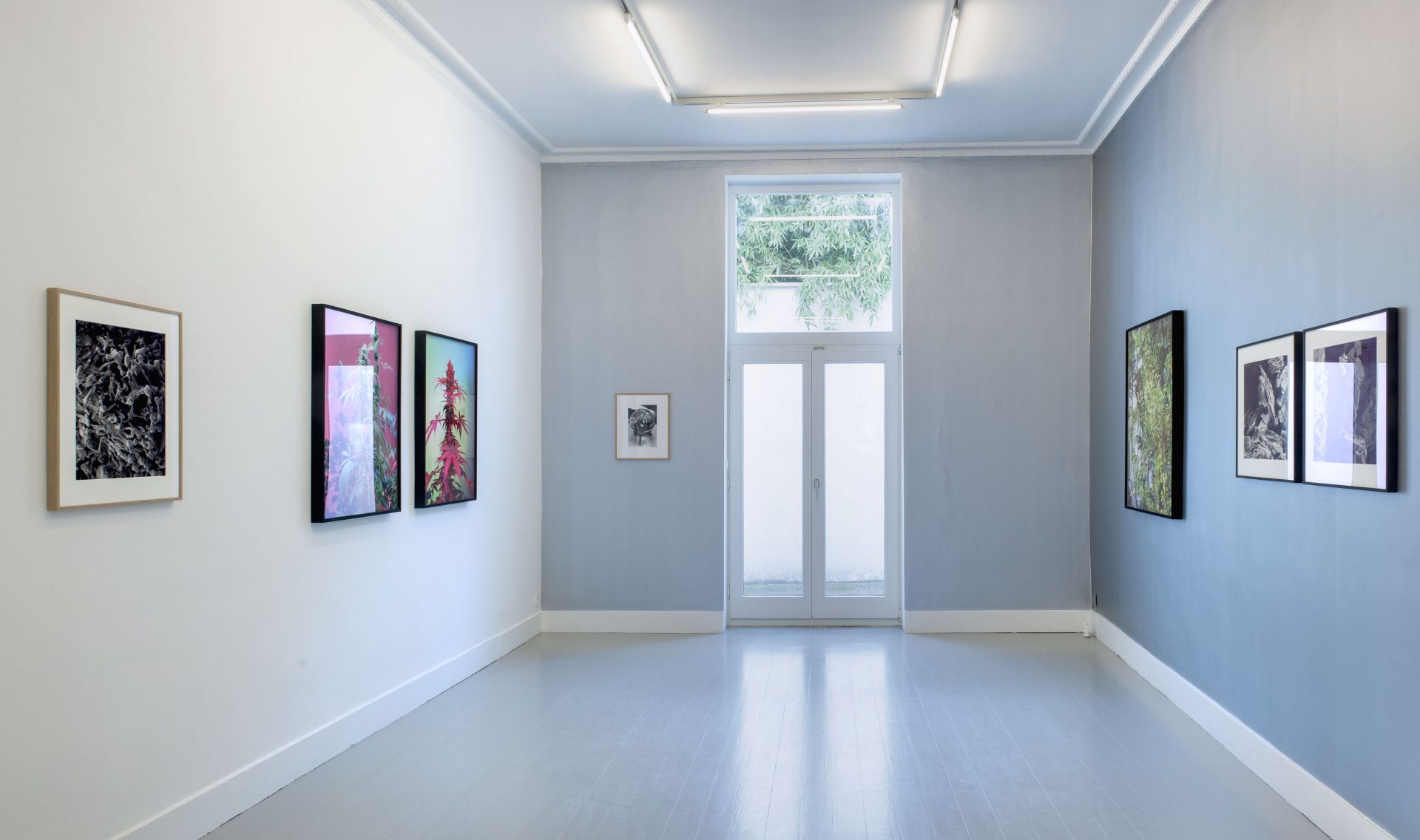
The invisible index, installation view at Jan Mot, 2021
From the Secret Garden of Sleep
In the mid-1970s a new type of imagery emerged in counter-cultural magazines such as High Times and Sinsemilla Tips. Cannabis plants dripping with resin would appear as centerfolds, modelled on the photographic style of Playboy. This interest in the physicality of the plant came at a time when an increasing number of people in the United States were growing cannabis themselves. The formerly lush Mexican fields were in shambles and a huge market for domestically grown marijuana had opened up.
The rise of domestic growing came to a halt in 1982 when the Reagan administration set out to crush the domestic marijuana industry. Not only did Reagan see the increase in home-grown marijuana as unpleasantly reminiscent of more lenient times, he also perceived the use of marijuana as an important symbol of the counter-culture — one that had to be eradicated. In the span of a few years, cannabis swung from being on the cusp of acceptance to being domestic enemy number one. The means for achieving this was fierce legislation against growers and users.
Little did the Reagan administration suspect that they had started a genetic revolution. As harsh sentences were implemented — for example, growing any amount of marijuana in Oklahoma could result in a life prison sentence — and surveillance and government control increased, domestic cannabis growing moved indoors and, ironically, a plant of wonder materialized. Amateur gardeners in the Pacific Northwest applied their talents to crossbreed cannabis indica and sativa strains, creating hybrids that thrived indoors, cultivated under blazing metal-halide light. Gone were the days of low-yield plants that sometimes grew to be as tall as five meters. Instead something like a muscular dwarf emerged, just knee-high, with buds the size of fists and a concentration of psychoactive compound significantly higher than before.
Psychoactive plants, like cannabis, can alter our experience of reality, bridging the world of matter and consciousness. In this history, consciousness, for better or worse, became inscribed into the very flesh of the plant as a consequence of desire, politics and legislation. With the series From the Secret Garden of Sleep I have made photographs of several strains of home-grown marijuana. These images of hybrids reflect a sub-genre of plant photography and point to the history behind the otherworldly appearance of modern cannabis.
Joachim Koester